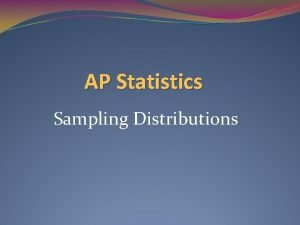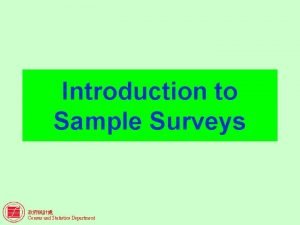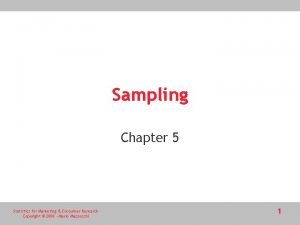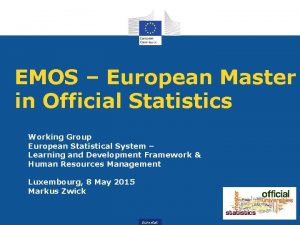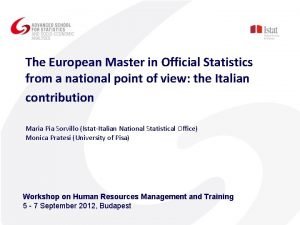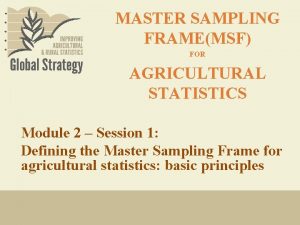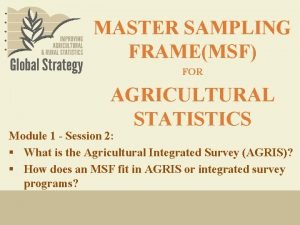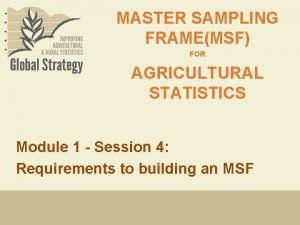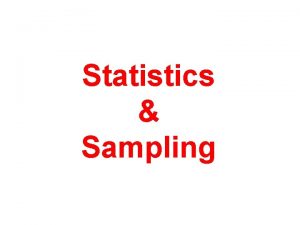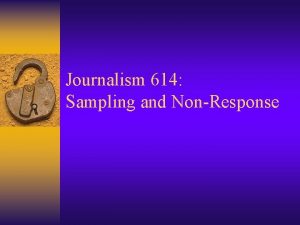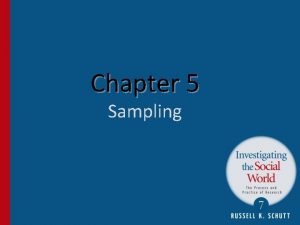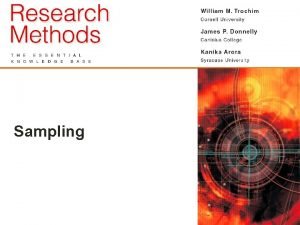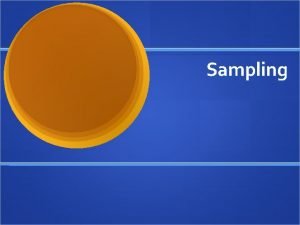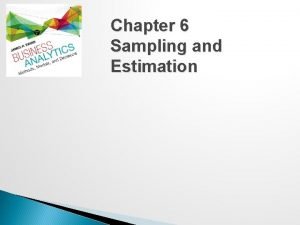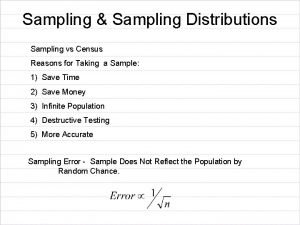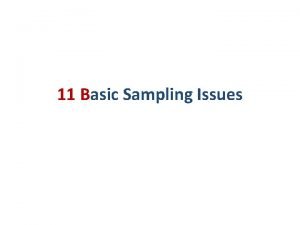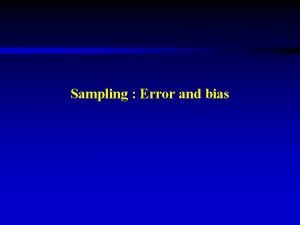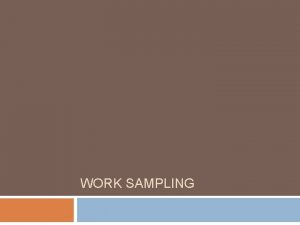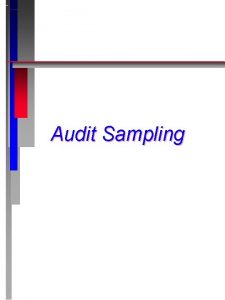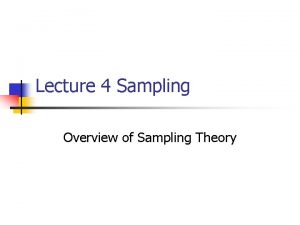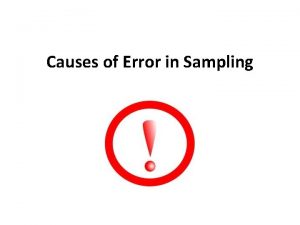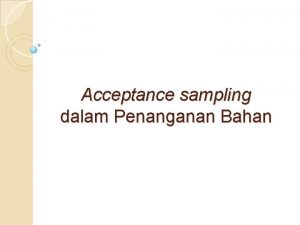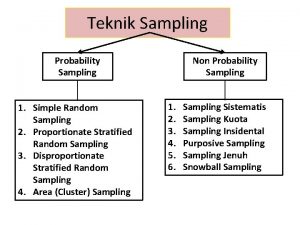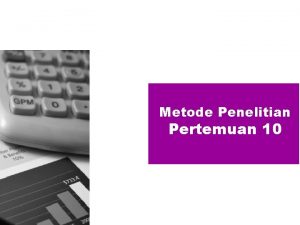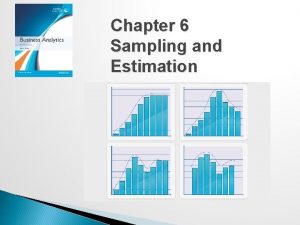MASTER SAMPLING FRAMEMSF FOR AGRICULTURAL STATISTICS Module 1


































- Slides: 34

MASTER SAMPLING FRAME(MSF) FOR AGRICULTURAL STATISTICS Module 1 - Session 1: Master Sampling Frame for agricultural statistics: basic principles

Objectives of the presentation • Introduce the concept of Master Sampling Frame (MSF) • Inform the audience about the benefits of constructing and using an MSF • Advocate for an agricultural survey system based on a single Master Sampling Frame 2

Outline • Introduction • Defining sampling frame and multiple frame sampling • Defining Master Sampling Frame • Reasons to build, use and maintain an MSF • The type of data that can be produced from using an MSF (relative to the SDGs and Minimum set of core data). 3

Introduction Departure point, observation Interrelation between agriculture, social dimension and environmental concerns (with its externalities, …) give rise to A necessar y condition Establishment of a consistent framework to obtain relevant data Integrated management and coordinated information 4

Introduction • What about the agricultural sector? Establishment of a Master Sampling Frame Collect consistent information that best meets the needs of users and policy makers 5

Introduction: conditions for collection of quality data • “There are two elements that are paramount to the success of a statistical survey, the two things for which one should drive the most care and concern, without which all the quality that can be obtained for the other elements of a survey may not ensure minimum quality of the results. These two elements are the master frame and fieldwork”(BOLLIGER F. , & al. 2015) 6

Introduction: One of the conditions for collecting quality data • In household surveys faulty sampling frames are a common source of nonsampling error, particularly under-coverage of important population sub-groups. (Turner, 2003) • “Need to elaborate best practices in frame construction and usage taking into account various stages of sampling. ” (Turner, 2003) • Countries experiences showed that the MSF is, indeed, a powerful tool for data integration • MSF is one of the main tools for establishing closer link between results from different statistical processes and statistical units 7

Introduction: GS advocacy • How does MSF fit in GLOBAL STRATEGY objectives? • The GS advocates for an agricultural survey system based on a single master frame • This approach guarantee complete integration and consistency of the estimates • This is in line with the Strategic directions of the Global Strategy 8

Strategic directions of the Global Strategy • Broaden Scope of Agricultural Statistics: ⁻ Add social and environmental dimensions ⁻ Include aspects of rural households, forestry and fishery ⁻ Include production from household plots • Translate policy into statistical language: ⁻ Connect farm holdings and rural households to the natural environment and land • Provide Conceptual Framework: three pillars: ⁻ Establish of a Minimum Set of Core Data (MSCD) ⁻ Integrate agriculture into National Statistical Systems ⁻ Improve the Sustainability of the Agricultural Statistical System (ASS) through governance and statistical capacity building 9

GS Second Pillar: Integration of Agriculture into national Statistical system • Coordinate data collections across sectors for agriculture, rural households, etc. ⁻ Eliminate duplication of work and conflicting estimates • One of the tools to achieve integration: ⁻ Develop Master Sample Frame for agriculture that will be the foundation for all data collection based on sample surveys • Before the GS, little guidance was available on building a MSF for agricultural surveys =>The GS Handbook on MSF for Agricultural Statistics (GS, 2015) and its supplement on countries’ experiences (GS, 2017) aim at filling this gap. 10

1 Definition of Basic Concepts 11

Definition of concepts • Sampled population • Sample • Sampling frame • Multiple frame sampling 12

Definition of concepts • Sampled population (or survey population): Population actually covered by a survey. • Sample: Subset of units, selected from a population for the purpose of collecting information from those units. The inference about the population as a whole is drawn from the findings based on that sample. 13

Definition of concepts • Sampling frame: any list, material or device that delimits, identifies, and allows access to the elements of the survey population* • Two basic types of Sampling Frames: area frames and list frames – List frame: exhaustive list of units in the survey population (e. g. a list of all agricultural holdings, a list of farm operators involved in agricultural activities…) – Area frame: Set of geographical unit which may be either points, transects or segments of land. Some examples: – Segments with physical boundaries: a river, a sequence of mountain peaks, etc. – Regular grids – Points (unclustered) – Hierarchy of geographical unit. In this case the area frame units at one level can be subdivided to form the units at the next level: region and Enumeration Areas within a region or a department. *http: //www. statcan. gc. ca/pub/12 -539 -x/2009001/coverage-couverture-fra. htm, 13/12/16, 4 pm 14

Definition of concepts Multiple sampling frame: Sampling frame created from a joint use of two or more sample frames Population Frame 1: Area Frame 2: Traditional list frame built upon census Frame 3: A list frame based on administrative data Examples of a multiple frame sampling in the Agricultural sector: • Use of several lists frames (List of food crop farmers, list of cash crop farmers. . ) • Use of an area and list frames (maps of EA, list of householdings, list of commercial holdings… 15

2 What is an Master Sampling Frame for agricultural statistics? 16

What is a Master Sampling Frame (MSF)? “A Master Sampling Frame is a sampling frame that provides the basis for all data collections through sample surveys and censuses in a certain sector, allowing to select samples for several different surveys or different rounds of the same survey, as opposed to building an ad-hoc sampling frame for each survey. (Carfagna, E. , 2013)” 17

What is a Master Sampling Frame (MSF) for agricultural statistics? For the agricultural sector and in the context of the Global Strategy: • The MSF is a sampling frame that can be used for several surveys or several rounds of the same survey • It enables the selection of different samples (including from different sampling designs) for specific purposes: – Agricultural surveys – Agricultural household surveys – Farm management surveys 18

What is a Master Sampling Frame (MSF) for agricultural statistics? (cont’d) For the agricultural sector and in the context of the Global Strategy (cont’d): • “MSF is a frame or a combination of frames that covers the population of interest in its entirety, and that enables the linkage of the farm as an economic unit to the household as a social unit, and both of these to the land as an environmental unit. ”(Handbook on MFS, 2015) • It helps to avoid building an ad hoc frame for each survey 19

What is a Master Sampling Frame (MSF) for agricultural statistics? (cont’d) • Traditional approach Sampling FRAME Household Survey Sampling FRAME Grain Survey Sampling FRAME Agricultural Survey Sampling FRAME Livestock Survey 20

What is a Master Sampling Frame (MSF) for agricultural statistics? (cont’d) • Approach suggested by MSF Household Survey MASTER SAMPLING FRAME Grain Survey Agricultural Survey Livestock Survey Sampling frame for multiple surveys, • each one using its own probability sample design Or for the same survey at different points in time: • Panel type surveys • Periodic surveys. Used in this way, a Master Sampling Frames can be an efficient tool to integrate surveys. 21

Examples of sampling frames that can be used as input to create a MSF • Population census enumeration areas (EA) • Household registers from population census • Agricultural census enumeration areas (same as population census Eas in many countries) • Registers of farms from agricultural census • Registers of farms based on administrative records • Area sample frames (EAs map or land cover maps) • Multiple frames (combination of any of the above) 22

3 Why should we used an MSF for agricultural statistics? 23

Why an MSF is needed and what issues it will address? THREE MAJOR BENEFITS: (1) Better coherence and data integration in NSS ⁻ Avoid duplication of efforts, ensure better coherence and reduce discrepancies in data from various surveys o Traditional approach vs MSF’s approach ⁻ Provide a stable reference system for agricultural surveys over time o An unique frame for various surveys ⁻ Connect various aspects of the sector and allow the analysis of sampling units from different viewpoints resulting in a better understanding of the sector 24

Why a MSF is needed and what issues it will address? (cont’d) (2) Cost effectiveness • The costs of building the MSF and selecting units will be shared by all the surveys using the master sample and • Use of modern technologies and various sources can reduce cost (Remote Sensing, GIS, administrative sources. . ) (3) Better planning and coordination • Facilitates the planning and coordination of regular surveys in an integrated survey program • Provides an effective tool for implementation of SPARS (integrated survey programme) and foundation for AGRIS (frame) 25

Few examples: is MSF really cost efficient? • Whenever an operation can be carried out once for two surveys, the cost of this operation will be saved. • The magnitude of the economy realized will depend on the cost of the operation. • Example: In the case of two stage sampling ⁻ If two surveys share the same list of PSUs, only the cost of the PSUs selection will be saved. This is not an important economy. ⁻ On the other hand, if two surveys use the same list of SSUs, the cost of updating the SSUs list will be a substantial economy. 26

Few examples: is MSF really cost efficient? • Furthermore, if a MSF is built for several surveys, but for a variety of reasons it is finally used only for a single survey, there will be a high risk of waste of resources. • In order to predict potential gains, consideration should be given to the programming of the various surveys. The size of each of these surveys. • Possible overlapping relationships between these surveys. • The likelihood that the survey program will be modified. 27

Few examples: is MSF really cost efficient? • The use of the MSF can make it possible to pool the human and material resources of several surveys. • Example: If several surveys concern the same PSUs ⁻ The same group of enumerators and supervisors can be recruited and trained for these surveys. ⁻ These enumerators will receive a solid basic training, and then a light training for each specific survey. ⁻ Using the same field staff also may involves financing the field equipment only once • The MSF can save time at the respondent level. Some questions common to several surveys will be asked to him once. This is particularly the case if the surveys are organized in an integrated framework. 28

Why an MSF is needed and what issues it will address? (cont’d) In fact, having a MSF is a necessary condition for the creation of integrated survey programs such as AGRIS* • The establishment of a MSF is an important condition for coordinated planning and optimal implementation of the integrated survey program. • a MSF therefore provides a sampling framework to cover all populations targeted by an integrated survey program. • In addition, in an integrated census and surveys programme, the use of a MSF facilitates: ⁻ benchmarking for the subsequent agricultural statistics surveys ⁻ and reconciliation of data from different surveys and sources. (WCA 2020) *Refer to presentation II for more details connection between MSF and AGRIS 29

4 • • Type of data that can be produced from an MSF? Minimum Set of Core Data (MSCD) Sustainable Development Goals (SDG) • • • Details could be found on the link below: SDG: https: //sustainabledevelopment. un. org/? menu=1300 MSCD: (Global Strategy, 2012) 30

MSF in connection with MSCD and SDGs • Since the MSF intends to cover the scope of more than one indicator, it should be developed in connection with MSCD and SDG’s indicators that could be gathered from agricultural and rural population (in compliance with the 3 GS’ pillars) • The MSCD and data as input for a monitoring of SDG’s indicators, should be a starting point in the process of establishing a MSF • The scope of MSCD and SDG’s indicators will allow to better guide the identification of target populations and sampling units to consider in the construction of a MSF: o Each item of MSCD can be represented by different populations from which data can be collected o As well as SDG's indicators 31

Summary about MSF • A master sampling frame is a general purpose sampling frame, for use in selecting samples for different surveys or different rounds of a periodic survey. (WCA 2020). • A master sampling frame has several benefits. It is quick and easy to conduct surveys of any kind, because a ready-made frame is already available. • Since different surveys or rounds of the same survey may take advantage of some features (sampling frame, training, …), the cost of preparing sampling materials and selecting samples is also reduced • Master sampling frames also make it easier to relate data from different surveys and to control the reporting burden on survey respondents. • It is a necessary condition to implement an integrated survey such as AGRIS • Based on countries experiences and researches conducted, GS advocates and encourage countries to adopt this timely, cost effectiveness approach to ensure and sustain quality agricultural statistics 32

References • Publications and working paper ⁻ FAO, 2015. World Programme for the Census of Agriculture 2020. FAO Statistical Development Series 15. , Vol. 1. Rome ⁻ Global Strategy to improve agricultural and rural statistics. , 2015. Handbook of Master Sampling Frame for Agricultural Statistics: Frame development, Sample design and Estimation. , Rome, Italy ⁻ Global Strategy to improve agricultural and rural statistics. , 2014. Plans Stratégiques Pour Les Statistiques Agricoles Et Rurales (PSSAR), Rome, Italy ⁻ Bolliger F. , Diniz da Silva A. , 2015, Brazilian Master Frame for Agricultural Statistics, ISI Scientific paper. • Working document ⁻ Global strategy, 2016; Nepal’s Master Frame Test Protocol. ⁻ Cristiano, F. , Leite, A. , Ospina, R. , et al. 2016. workshop on master sampling frame for agriculture surveys, Harare, Zimbabwe. UNECA ⁻ World Bank. , 2010, Integrating Agriculture into National Statistical System, Workshop ⁻ Turner, A. , 2003. Sampling frames and master samples. UNSD, Expert Group Meeting to Review the Draft Handbook on Designing of Household Sample Surveys 3 -5 December 2003. 33

Thank You
 A consumer confidence researcher asks several retailers
A consumer confidence researcher asks several retailers Cluster sampling vs stratified random sampling
Cluster sampling vs stratified random sampling Stratified random sample vs cluster sample
Stratified random sample vs cluster sample Contoh event sampling
Contoh event sampling Cluster random sampling vs stratified
Cluster random sampling vs stratified Sample frame in research example
Sample frame in research example Natural sampling vs flat top sampling
Natural sampling vs flat top sampling Ap statistics sampling distributions
Ap statistics sampling distributions Sampling methods statistics
Sampling methods statistics Convenience sampling statistics definition
Convenience sampling statistics definition Introduction to statistics what is statistics
Introduction to statistics what is statistics Master emos
Master emos European master in official statistics
European master in official statistics C device module module 1
C device module module 1 Kontinuitetshantering
Kontinuitetshantering Typiska drag för en novell
Typiska drag för en novell Nationell inriktning för artificiell intelligens
Nationell inriktning för artificiell intelligens Vad står k.r.å.k.a.n för
Vad står k.r.å.k.a.n för Varför kallas perioden 1918-1939 för mellankrigstiden
Varför kallas perioden 1918-1939 för mellankrigstiden En lathund för arbete med kontinuitetshantering
En lathund för arbete med kontinuitetshantering Underlag för särskild löneskatt på pensionskostnader
Underlag för särskild löneskatt på pensionskostnader Tidbok yrkesförare
Tidbok yrkesförare Anatomi organ reproduksi
Anatomi organ reproduksi Densitet vatten
Densitet vatten Datorkunskap för nybörjare
Datorkunskap för nybörjare Boverket ka
Boverket ka Hur skriver man en debattartikel
Hur skriver man en debattartikel Delegerande ledarstil
Delegerande ledarstil Nyckelkompetenser för livslångt lärande
Nyckelkompetenser för livslångt lärande Påbyggnader för flakfordon
Påbyggnader för flakfordon Lufttryck formel
Lufttryck formel Svenskt ramverk för digital samverkan
Svenskt ramverk för digital samverkan Bo bergman jag fryser om dina händer
Bo bergman jag fryser om dina händer Presentera för publik crossboss
Presentera för publik crossboss Teckenspråk minoritetsspråk argument
Teckenspråk minoritetsspråk argument







